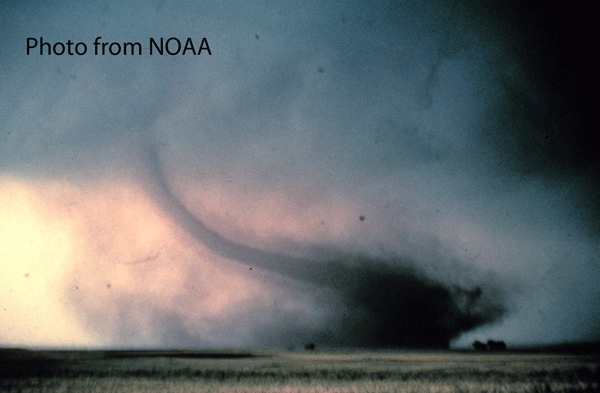
April tornadoes change upper Southeast cropping plans
• Huge jumps in cotton acreage are expected in both North Carolina and Virginia and the big storm system may have increased the amount of cotton that will be planted.• Corn planting was already delayed in most of North Carolina and was just beginning in southeast Virginia.• Wheat was little-affected by the storm, other than from debris that littered fields from the southern end of North Carolina and through the Tidewater area of Virginia.
May 17, 2011

On April 16, a line of severe storms produced more than 60 tornadoes that ripped a 50-mile wide, 200 mile long zigzag path of destruction from southern North Carolina to the middle peninsula of Virginia, leaving a path of death and destruction and changing the spring planting plans of farmers in the two-state area.
Huge jumps in cotton acreage are expected in both North Carolina and Virginia and the big storm system may have increased the amount of cotton that will be planted.
Corn planting was already delayed in most of North Carolina and was just beginning in southeast Virginia. The storm dumped torrential rainfall throughout its path, further complicating corn planting.
Wheat was little-affected by the storm, other than from debris that littered fields from the southern end of North Carolina and through the Tidewater area of Virginia.
With more than 60 documented tornadoes, some of which stayed on the ground more than 30 miles, the amount of storm debris generated is staggering. Though most of the litter that covered farm fields in mid-April has been removed — at least along the direct paths of the tornadoes, the delay in planting dates will likely change planting plans for hundreds of farmers.
Ten counties in North Carolina were declared federal disaster areas and gave farmers access to low interest money to rebuild farm structures and help in debris removal. The problem in most of these rural counties is finding people willing to do the work.
In some of the most heavily damaged areas growers may be able to collect insurance on fields heavily littered with debris from the storm. In some cases, collecting insurance, burning down the standing wheat and cleaning up the field may be a better option than risking damage to a $300,000 combine.
Though destroying wheat to clean up fields may be an option, if it occurs, it’s not likely to be on a scale large enough to significantly impact wheat production in either state.
Corn
The USDA planting intentions survey released at the end of March called for 890,000 acres of corn in North Carolina, down 2 percent from 2010.Virginia was expected to produce another 510,000 acres, up 4 percent from 2010.
Timely planting not an option
How much the storm system changed planting plans for corn won’t be known until long after the crop is planted. In some areas along the storm’s path timely planting wasn’t an option.
Late planting was an option and from agronomic standpoint that won’t likely be a big issue.
Veteran North Carolina State University Corn Specialist Ron Heiniger says the storm created a real mess in the heart of the state’s corn belt. However, he says the delayed planting date prior to the storm may have been a blessing.
In the southern end of the state, some corn had been planted, but surprisingly not a lot, Heiniger says. “Some of it was planted, but hadn’t emerged and other fields were about to the G3 stage — the largest corn I had seen prior to the storm. Damage to corn at this stage of growth usually reduces yield by about 10 percent,” he adds.
The huge amounts of debris in fields no doubt slowed down corn planting, but dryer, more seasonal weather following the storm has helped fields dry out and has improved planting conditions. As long as growers got corn planted by May 15, they should be okay from a yield standpoint, Heiniger says.
“Though growers could replant without too much penalty, right now I’m not recommending that,” Heiniger says. “When you plan for a replant, you have to worry about burning it down and re-disking, all of which takes time and money,” he adds.
“There was a good window of opportunity to planting from the end of April through mid-May. Our data indicates you don’t lose much if you get corn in by May 15.”
Heiniger urged growers to not panic, get things cleaned up, debris removed and there is still time to get corn planted. How many growers took his advice remains to be seen.
Cotton
Pushing corn planting back to early May likely won’t have a big effect on the corn crop, but it puts a serious crimp in putting in other crops, primarily cotton.
“From past experience with tornado damage there will be some strange things found in fields — you just hope you find some of these things before you run over them with a wheat combine or a planter,” says long-time North Carolina Crop Consultant Bill Peele.
“Some of the areas hit by the storms in April will be obliterated with litter from the tornadoes, and the farmer knows he has to get in there and get all that stuff out before he can harvest or plant a crop.
In other areas, sometimes a long distance from where a tornado came through you will be walking in a field and pick up a 2-3 foot long piece of a 2X4. So, growers are going to have to take a lot of extra time looking at fields to be sure it’s safe to plant and that’s going to take some extra time,” Peele adds.
“Pushing cotton planting dates back a few weeks, up until May 15, won’t make a significant impact on yields, if other stress factors don’t occur,” Peele says.
“We’ve planted cotton in June, behind wheat, and it did okay. Real late planted cotton typically has plenty of bolls on the plant and many won’t open. So, planting much past the first week of June is going to be a real problem,” he adds.
Early maturing varieties
“Once growers get past the second week of May, they will need to consider planting early maturing varieties. The window for getting all the things done that need to be done to a cotton crop and getting it out before frost becomes a challenge,” he says.
Typically. cotton is planted from mid-April until the first week or two in May. With so much of the corn crop not planted when the storm system struck on April 16, there is some speculation some growers may forego planting corn and plant cotton, if they can find the extra seed.
Already, North Carolina growers were expected to plant 750,000 acres of cotton, an increase of 36 percent over last year.
In Virginia the increase is expected to be even larger, a 51 percent increase, topping 125,000 acres.
The big increase in cotton acreage in North Carolina and Virginia, combined with smaller increases in neighboring states, has put a strain on seed supply. So far, as of early May, it appears most growers got enough seed, though not always in their top 2-3 choices of variety. How much seed is left over for late-planted cotton is uncertain.
Soybeans
Historically, soybeans have been the last of the major row crops to be planted in the upper Southeast. In both Virginia and North Carolina a sizable percentage of the soybean crop is planted behind wheat or barley.
While the impact of the April storm system appears to have the least affect on soybean acreage, delayed planting of other row crops and the slow harvest process for wheat could have either a positive or negative affect on soybean acreage.
There is no doubt wheat harvesting will be slowed down as growers pay careful attention to spotting debris left in their fields from the April storm system. Having the elevation of the combine will make their task easier. However, all along the 200 or so mile path of the storms, growers will be on edge as they combine wheat.
Charles Hall, executive director of the North Carolina Soybean Association says the jury is still out on how much impact the April storms will have on soybean production in the state.
At the time the storm hit, only about a third of the corn acreage projected for North Carolina had been planted. Typically by mid-April more than half the state’s corn crop is planted. How much of intended corn acreage will be planted to corn remains to be seen.
Delays in planting will clearly push many farmers near the late planting date after which yield potential is affected.
Cotton is natural benefactor
Cotton is a natural benefactor of reduced corn, but seed supply may dissuade farmers from planting it. Soybean seed appears to be in good supply.
“I haven’t heard anything about soybean seed shortages. If growers decide to plant soybeans, instead of late-planted corn, I think there will be an adequate seed supply,” Hall says.
Late planted beans, planted behind wheat should not be significantly affected. North Carolina has nearly 700,000 acres of wheat planted and a lot of that crop was targeted to have soybeans planted behind it.
How much, if any, the slow-go on wheat harvest will have on getting double-crop soybeans planted isn’t certain.
Clearly, a lot of decisions on what to plant and when to plant it will depend on how much time it takes to get debris out of fields and how soon growers were able to get back into their fields after the torrential downpours that accompanied the April storm system.
About the Author(s)
You May Also Like





